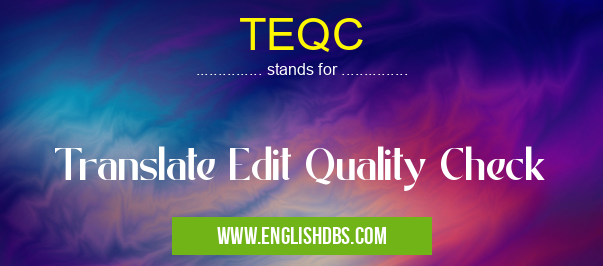What does TEQC mean in UNCLASSIFIED
TEQC stands for Translate Edit Quality Check. It is a process used to ensure the quality of translated content by reviewing and editing translations for accuracy, consistency, and linguistic quality.

TEQC meaning in Unclassified in Miscellaneous
TEQC mostly used in an acronym Unclassified in Category Miscellaneous that means Translate Edit Quality Check
Shorthand: TEQC,
Full Form: Translate Edit Quality Check
For more information of "Translate Edit Quality Check", see the section below.
What does TEQC involve?
TEQC involves the following steps:
- Translation: The original content is translated into the target language.
- Editing: The translation is reviewed and edited for grammar, spelling, punctuation, and style.
- Quality Check: The edited translation is checked for accuracy, completeness, and compliance with the quality standards of the organization.
Why is TEQC important?
TEQC is important for the following reasons:
- Accuracy: Ensures that the translated content accurately conveys the meaning of the original content.
- Consistency: Maintains consistency in terminology, style, and formatting across translations.
- Linguistic Quality: Improves the overall linguistic quality of the translated content, making it clear, concise, and easy to understand.
How is TEQC performed?
TEQC can be performed manually or using automated tools. Manual TEQC involves a human reviewer checking the translation against the original content, while automated tools use algorithms to identify and flag potential errors.
Essential Questions and Answers on Translate Edit Quality Check in "MISCELLANEOUS»UNFILED"
What is TEQC (Translate Edit Quality Check)?
TEQC is the evaluation of machine-translated content by human reviewers to ensure it meets specific quality standards. It involves assessing the accuracy, fluency, and cultural appropriateness of the translation.
Why is TEQC important?
TEQC helps ensure that machine-translated content is reliable, intelligible, and suitable for its intended audience. It helps prevent misunderstandings and misinterpretations that can arise from poor-quality translations.
What are the key aspects of TEQC?
Key aspects include:
- Accuracy: Checking that the translation correctly conveys the meaning of the original text.
- Fluency: Ensuring that the translation reads smoothly and naturally in the target language.
- Cultural appropriateness: Adapting the translation to the cultural context and audience of the target language.
How is TEQC performed?
TEQC is typically carried out by experienced human translators who:
- Compare the machine-translated text to the original source text.
- Highlight any errors or inconsistencies.
- Make necessary corrections and improvements.
What are the benefits of using TEQC?
TEQC offers several benefits:
- Improved accuracy and reliability of translated content.
- Enhanced user experience for readers of the translated text.
- Mitigation of potential risks associated with inaccurate translations.
- Increased trust and credibility in machine-translated content.
Is TEQC necessary for all machine translations?
The need for TEQC depends on the intended use and importance of the translation. For critical or high-stakes translations, TEQC is highly recommended to ensure the highest possible quality.
Final Words: TEQC is an essential process for ensuring the quality of translated content. By following the steps of translation, editing, and quality checking, organizations can produce accurate, consistent, and linguistically sound translations that effectively communicate their message to a global audience.
